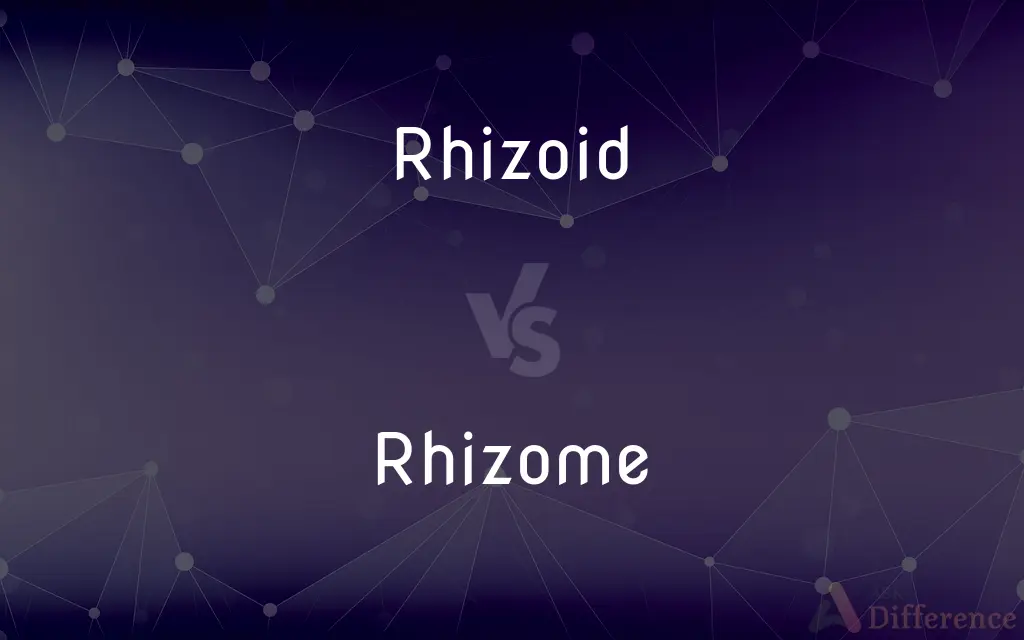Rhizoid vs. Rhizome — What's the Difference?
By Fiza Rafique & Maham Liaqat — Updated on April 22, 2024
Rhizoids are root-like structures anchoring non-vascular plants, while rhizomes are horizontal underground stems that store nutrients and help in vegetative reproduction.

Difference Between Rhizoid and Rhizome
Table of Contents
ADVERTISEMENT
Key Differences
Rhizoids are small, hair-like structures that serve mainly as anchoring devices for plants such as mosses and liverworts. These are not true roots but perform some similar functions, such as helping the plant attach to a substrate. On the other hand, rhizomes are true plant stems that grow horizontally underground, found in various vascular plants like ginger and ferns.
Rhizoids lack vascular tissue, which means they do not conduct water or nutrients throughout the plant. This limitation reflects their role in non-vascular plants, which rely on direct water absorption from their surroundings. Whereas rhizomes contain vascular tissues, enabling them to transport nutrients and water to different parts of the plant, facilitating growth and survival.
In terms of reproduction, rhizoids do not play a direct role in the reproductive process; they are primarily for support and minimal water absorption. Conversely, rhizomes are crucial for vegetative reproduction, giving rise to new shoots that can become independent plants.
Rhizoids are typically single cells or filaments of cells in simpler plants. This simplicity suits their basic function in non-vascular organisms. Rhizomes, however, are more complex, often with multiple layers of tissue and the capability to store starch and other nutrients, enhancing the plant’s resilience and perennial growth.
Rhizoids help non-vascular plants colonize environments where soil is sparse, such as rocks and tree bark, contributing to ecosystem formation. Rhizomes contribute to the spread of their host plants, often enabling them to dominate large areas, which can be crucial in stabilizing soil and influencing ecological succession.
ADVERTISEMENT
Comparison Chart
Type
Root-like structures
Horizontal underground stems
Function
Anchoring, minimal water absorption
Nutrient storage, vegetative reproduction
Presence of Vascular Tissue
No
Yes
Role in Reproduction
Minimal, no direct involvement
Crucial, enables reproduction
Ecological Role
Colonization of non-soil environments
Soil stabilization, spread and dominance
Compare with Definitions
Rhizoid
A structure resembling a root, seen in non-vascular plants.
Mosses use rhizoids to secure themselves to rocks.
Rhizome
Capable of producing the shoot and root systems of a new plant.
New fern plants spring from the rhizomes of the parent.
Rhizoid
A filamentous outgrowth that anchors lower plants.
Rhizoids are crucial for liverworts thriving on damp surfaces.
Rhizome
A stem that grows horizontally under or along the ground.
Bamboo spreads quickly due to its rhizome system.
Rhizoid
Single-celled or multicellular structures not involved in nutrient transport.
Unlike roots, rhizoids do not transport nutrients across the plant.
Rhizome
An underground plant stem serving as a storage organ.
Ginger plants store starch in their rhizomes.
Rhizoid
Primarily found in bryophytes and some algae.
Rhizoids are characteristic of the bryophyte lifecycle.
Rhizome
Found in many perennial plants.
The iris flowers regrow each year from their rhizomes.
Rhizoid
A non-vascular organ that absorbs water and minerals.
In mosses, rhizoids absorb minimal nutrients from their substrate.
Rhizome
Involved in vegetative reproduction.
Grasses utilize rhizomes to reproduce and expand their territory.
Rhizoid
Rhizoids are protuberances that extend from the lower epidermal cells of bryophytes and algae. They are similar in structure and function to the root hairs of vascular land plants.
Rhizome
In botany and dendrology, a rhizome (, from Ancient Greek: rhízōma (ῥίζωμα) – "mass of roots", from rhizóō (ῥιζόω) "cause to strike root") is a modified subterranean plant stem that sends out roots and shoots from its nodes. Rhizomes are also called creeping rootstalks or just rootstalks.
Rhizoid
A slender rootlike filament that grows from an alga, a fungus, or the gametophyte of a moss, liverwort, or fern, used for attachment and nourishment.
Rhizome
A horizontal, usually underground stem that often sends out roots and shoots from its nodes. Also called rootstock.
Rhizoid
(botany) A rootlike structure in fungi and some plants that acts as support and/or aids the absorption of nutrients.
Rhizome
(botany) A horizontal, underground stem of some plants that sends out roots and shoots (scions) from its nodes.
Rhizoid
Resembling the root of a plant.
Rhizome
A so-called “image of thought” that apprehends multiplicities.
Rhizoid
A rootlike appendage.
Rhizome
A rootstock. See Rootstock.
Rhizoid
Any of various slender filaments that function as roots in mosses and ferns and fungi etc
Rhizome
A horizontal plant stem with shoots above and roots below serving as a reproductive structure
Common Curiosities
Can rhizomes contribute to plant reproduction?
Yes, rhizomes are vital for vegetative reproduction, allowing plants to spread and produce new individuals.
What distinguishes a rhizome from a root?
Rhizomes are stems that grow horizontally underground, capable of storing nutrients and producing new growth, unlike roots which are primarily for nutrient absorption.
What is the main function of rhizoids?
Rhizoids primarily serve to anchor non-vascular plants to their substrate.
How do rhizomes help a plant?
They store nutrients, help in vegetative reproduction, and allow the plant to survive adverse conditions.
Do rhizoids have any role in photosynthesis?
No, rhizoids do not participate in photosynthesis; they are primarily for anchoring.
Where are rhizoids found?
Rhizoids are found in mosses, liverworts, and some algae, mainly in non-vascular plants.
Is there a difference in the complexity between rhizoids and rhizomes?
Yes, rhizomes are more complex, containing vascular tissues, whereas rhizoids are simpler and lack these tissues.
Are rhizoids capable of absorbing nutrients?
Rhizoids can absorb minimal water and nutrients, but are not primarily for nutrient absorption.
Can rhizoids be considered true roots?
No, rhizoids are not true roots; they are simpler structures that perform limited functions.
Are rhizomes visible above the ground?
Typically, rhizomes grow beneath the surface, though parts may become exposed.
What types of plants commonly have rhizomes?
Many grasses, ferns, and perennial plants have rhizomes.
What advantage do rhizomes give to invasive species?
Rhizomes allow invasive species to spread rapidly and dominate areas by producing new plants.
How do rhizoids and rhizomes contribute to their ecosystems?
Rhizoids help non-vascular plants colonize harsh environments, while rhizomes can stabilize soil and contribute to vegetative spread in their ecosystems.
How do environmental conditions affect rhizome growth?
Favorable soil, moisture, and temperature conditions can enhance rhizome growth and spread.
Can rhizoids grow into rhizomes?
No, rhizoids and rhizomes are distinct structures and one cannot transform into the other.
Share Your Discovery

Previous Comparison
March vs. Match
Next Comparison
Initialisation vs. InitializationAuthor Spotlight
Written by
Fiza RafiqueFiza Rafique is a skilled content writer at AskDifference.com, where she meticulously refines and enhances written pieces. Drawing from her vast editorial expertise, Fiza ensures clarity, accuracy, and precision in every article. Passionate about language, she continually seeks to elevate the quality of content for readers worldwide.
Co-written by
Maham Liaqat














































